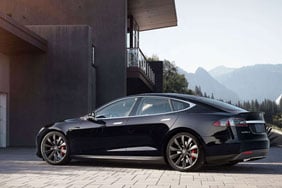When it comes to electric vehicle (EV) adoption, there's no doubt that the UK is making good progress.
As of August 2023, electric cars made up 27.8% of new car sales in the UK, according to data from Zapmap. Meanwhile, across Europe, 3% of vehicles on the road are now electric, a proportion that's roughly doubled each year since 2019.
In fact, the UK is currently ahead of the government's targets for 22% of car sales to be EVs. That's according to the Climate Change Committee's (CCC) 2023 report to Parliament.
Despite this, the CCC report states more urgency is needed to hit our goal of halting sales of internal combustion engine (ICE) vehicles by 2035.
In this article, I discuss the transition from petrol to electric vehicles, and consider the implications for consumers and the insurance industry.
The state of EV adoption in the UK
Compared to its international peers, the UK is doing well at adopting EVs. Ernst & Young ranks the country fifth globally for EV transition readiness. Among European nations, we're ninth in EV sales as a proportion of all car sales.
EY's latest Mobility Consumer Index has found that 38% of UK consumers are leaning towards an EV or a hybrid for their next purchase.
The data is clear: The UK is making real progress in the transition from petrol to electric.
One of the drivers of the early adoption market was government grants that helped reduce the costs of EVs for consumers.
As of 2023, these grants no longer exist, making the UK the only large European country without an EV subsidy. Analyses suggest that grants helped to increase EV car sales from under 1,000 in 2011 to over 100,000 at the start of 2022.
Without these grants, there's a risk that EV car adoption might slow down.
Still, even without grants, many factors are going right in the UK's plan for EV adoption:
- There's political consensus that EVs are the future. While prime minister Rishi Sunak has delayed the ban on ICE sales from 2030 to 2035, EV regulation is still in place. We're seeing more and more low-emission zones pop up across the country.
- The number of charging points is rapidly increasing. According to Zapmap's data, the UK has seen a 40% increase in charge points in the year to August 2023. A widespread network of charging points is essential for drivers. This network will help combat EV's 'charging anxiety' - a fear of running out of charge too far from a charging point. This is one of the main worries that discourages consumers from switching to EVs.
- The private sector is supporting the market as a valuable source of innovation. For instance, Zapmap is an app drivers can use to find EV charging points. This makes it easier for EV drivers to find places to refuel over long distances, helping to reduce charging anxiety. It's an inspiring example of a private company whose service has become central to the UK's EV infrastructure.
The automotive industry has shown that it can sell electric vehicles.
The challenge now is ensuring regular consumers can fit EVs into their everyday lives.
What still needs to happen for EV adoption to become mainstream?
For the UK to meet its targets, everyone who owns an ICE car right now needs to be able to buy and live with an EV. There are 3 changes I think we need to see to make that a realistic prospect.
1. Electric vehicle costs still need to come down
While costs have decreased in recent years, EVs are still substantially more expensive than ICE vehicles.
Data from JATO shows that in Europe, the average price of a new EV is 27% more than its ICE equivalent. In fact, no new EVs were available in Europe or the US under €20,000 (US$21,300/£17,414).
These prices are a barrier to broader market access. And they're compounded by other costs, too. For instance, insurance costs for EVs are typically higher, and vehicle parts remain more expensive.
There are also concerns around the second-hand car market. While new EVs are too expensive, second-hand electric cars aren't widely trusted, and there are limited options compared to used ICEs.
That's largely because we don't yet know for how long older batteries will keep their charge. Estimates suggest they can last for 15 to 20 years, but few EV batteries in the market have reached this age.
It poses a big risk for the consumer. If someone decides to buy second-hand and the battery doesn't hold its charge, the cost of replacing that battery will likely be high.
A common argument for EVs is that they're cheaper over their entire lifespan thanks to lower vehicle excise duty and no ULEZ charge. But even these calculations are no longer as compelling as they once were.
For one, EV drivers will have to pay tax from 2025, and ULEZ charges currently only apply to older cars - so you don't need an electric car to use low emissions zones.
But the main issue making EVs seem less valuable is the increased electricity price. Typical household energy bills increased by 54% in April 2022 and 27% in October of that year. While they've fallen since then, they remain well above early 2022 levels, which will affect the cost of charging an EV at home.
2. Charging infrastructure needs to be improved
In 2022, the UK government announced a £1.6 billion investment to improve charging infrastructure, promising 300,000 new charging points nationwide by 2030.
There are currently just under 50,000 charging points in the UK. But according to EY, we'll need 20 million EV chargers by 2040 - 88% of which we'll need in private homes.
That means we need 2.4 million public chargers by the end of the next decade. In this context, the 300,000 charge points promised by the government are not nearly enough.
One of the factors holding back EVs most is 'charging anxiety'. Without enough public charging points, potential EV drivers will continue to have concerns about travelling long distances. And this will likely remain a barrier to mainstream adoption.
One of the most urgent questions in this context is: Who should pay for this public infrastructure? The government is doing its bit, but car manufacturers may have to contribute if EV infrastructure is to become widespread. One way they can do this is by working towards a unified public charging network.
For instance, Tesla has installed charging stations nationwide, but these are only available to Tesla customers. If every manufacturer did the same, it would make the charging infrastructure challenging to navigate for consumers and greatly limit the accessibility of EVs.
When it comes to private charging, it might sound easy enough to charge your vehicle on your driveway. But that's not helpful for the third of UK homeowners who don't have a driveway or garage.
Another downside is the cost of domestic electricity. To address this, many EV drivers are turning to solar panels to meet their charging needs. Data shows that EV drivers are 7 times more likely to have domestic solar panels installed than other consumers. But like EVs themselves, solar panels come with significant upfront costs, which many people can't afford.
For EVs to become mainstream, the UK needs to work on its charging infrastructure and look to lower its electricity costs.
3. There needs to be more investment in supply chains and EV skills
One of the biggest challenges of EV adoption is car repairs and maintenance. As EVs use electric motors and large batteries, mechanics will need the expertise to repair these new technologies.
EV maintenance issues like motor repair and software issues require knowledge that's highly specialist and in short supply. There'll likely be a shortage of about 16,000 electric vehicle-qualified mechanics come 2032. That's according to data from the Institute of the Motor Industry published in The Guardian.
This shortage contributes to the already high cost of repairing an electric vehicle. According to one 2022 study, average costs for an EV breakdown were £596, compared to £221 for an ICE vehicle.
Yet these prices aren't just about the cost of specialist labour. EV parts are much more difficult to source, particularly as there's often still a waiting list for new models.
How the transition to electric affects the insurance industry
The rise of EVs will likely change the insurance market in 2 main ways.
1. Car insurance costs may increase
The cost of insuring an EV is currently a lot higher than for ICE vehicles. And there's no real sign that will change, at least not in the short or medium terms. In fact, the cost is actually increasing.
The latest Confused.com car insurance price index reveals that car insurance now costs £924 in Q3 2023. This is compared to £586 in Q3 2022. Yet Confused.com's own data shows that, for EVs, it's an increase of 72%, while for ICE drivers, it's only 29%.
Many factors contribute to these higher prices. One is that insurers just don't have the experience of pricing premiums for EVs, as the industry is still in its infancy.
That's compounded by the fact that most people aren't used to driving an EV. Unlike ICEs, EVs have instant acceleration, which can take drivers a bit of getting used to. Similarly, braking can feel different in an EV. The brakes will activate as the driver lifts their foot off the accelerator, even before you hit the brake pedal.
Consider, too, that EVs are much quieter than ICE vehicles, which can be dangerous. There's concern that the quietness of EVs could lead to more accidents. And for insurers, that means more claims - which will inevitably mean higher premiums.
Of course, the labour and parts associated with EV repairs are more expensive, too. As such, there are plenty of good reasons why EV insurance coverage is higher. But this is not good news for anyone.
It's not sustainable for some EV drivers to pay thousands of pounds per year for their insurance. Also, it doesn't help anyone if insurers simply decide not to insure customers at all due to costs. This was what John Lewis recently decided not to do.
So, for the sake of wider adoption, what can insurers do to bring premiums down?
All of us in the industry should work to ensure that companies have a network to source skills and parts as cheaply as possible. Then we can hope that, as more EVs hit the road and technology advances, some of the costs will come down by themselves.
2. More people may use car subscriptions to get access to EVs
Many drivers are turning to different payment models to access electric vehicles so they can avoid the upfront costs of buying an EV. It's something insurers should be well aware of.
One of the most common of these is car subscriptions. In this car-as-a-service model, drivers can sign up for a subscription service, like Elmo or Mycardirect, and have access to a vehicle that they pay for monthly.
This monthly payment includes everything a driver needs to run the vehicle: Maintenance, tax, and insurance.
Research from Wagonex, a subscription company, found that 9 million UK consumers would consider using vehicle subscriptions in the future.
If this trend continues, there's no doubt that the way insurers engage with consumers will have to change. For example, as more drivers access insurance through subscription companies, there's a good chance that insurers' direct-to-consumer market may decrease.
Insurers could be better off focusing on B2B opportunities by forging relationships with car subscription companies or manufacturers themselves.
As car subscriptions grow, insurers could remain more appealing to consumers by offering more flexible plans so that consumers only pay for the miles they drive. It could give consumers the flexibility they get from subscriptions while bringing down the cost of EV insurance.
Learn more about car as a service and how it's affecting the insurance industry.
How Confused.com is adapting to the EV transition
At Confused.com, we're following these changes in the EV industry closely. As a price comparison website (PCW), it's our job to cater to all of our customers' needs and give them an experience in line with current demands.
For us, that starts with ensuring we can cover every type of vehicle on the market. To do that, we invite a huge range of insurers - including specialist EV insurers - to our panel. This lets our customers find insurers willing to cover EVs and then find the best deals available among them.
It also involves ensuring that policies cover issues that are specific to EVs. For example, cover for problems like using the wrong fuel is no longer relevant, but issues like running out of charge or electrical faults will become more prevalent.
Plus, through our panel, Confused.com offers customers access to various types of insurance, including flexible deals and short-term car insurance.
Yet our role goes beyond insurance. We're helping consumers adjust to the EV transition through useful content, such as providing our customers with up-to-date charge point maps.
The transition to EVs is moving quickly - but there's still a way to go
The electric vehicle transition is undoubtedly picking up speed. But for EVs to truly become mainstream, policymakers, manufacturers, insurers, and PCWs must work together to make EVs accessible to the consumer.
Discover more about how we're working towards a better future at Confused.com.







